| |
STRATIGRAPHY AND DEPOSITIONAL ENVIRONMENT
The formation that includes "Sharktooth Hill" is locally referred to by geologists as the "Round Mountain Silt". Located in Kern County, California, it was deposited by a river delta coming out of the mountains to the east of Bakersfield. At this time (Middle Miocene) most of central California was covered by a small sea. The transformation of Bakersfield area from beachfront to near-desert could be summed up as the result of the overall trend of falling sea level, significant uplift of the Sierra Nevadas, and gradual landlocking of the Temblor Sea. The Southern Bakersfield region continued to exist as a swampy area well into the Pleistocene. At the same time the Miocene deposits eroded into a hilly area with many gullies exposing the so-called "Upper Layer of the Round Mountain Silt". This is the layer containing the bonebed which has yielded the most diverse and best-studied Tertiary fossil marine vertebrate assemblage yet known from anywhere within the Pacific Realm.
This fossil assemblage, called the Sharktooth Hill Local Fauna (Wood et al., 1941), is comprised of more than one hundred species of sharks, rays, bony fish, turtles, birds and mammals, including terrestrial species from the adjacent Miocene land mass (south of where Bakersfield currently is located). The "Round Mountain Silt" covers approximately 110 square miles. The Sharktooth Hill Bonebed is a single, relatively thin, but widespread horizon -- this fossil producing layer is only 6-8" thick (with some exceptions).
The STH Bonebed was recently assigned a Middle Miocene age between 15.2 and 16.0 million years old by Sanchez & Prothero (2003).
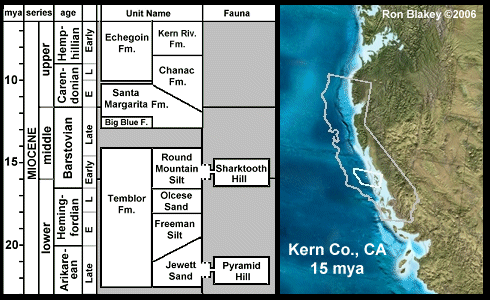 |
Correlation chart integrated by Jim Bourdon 2008.
Paleomap reproduced with the permission of Dr. Blakey 2007. |
CHONDRICHTHYAN FAUNA
In 1998, the original species list obtained from the Buena Vista Museum (BVMNH) included unfamiliar taxa with unlocatable descriptions. Elements of this list remain below as placeholders for those potential tooth-designs. In addition, taxa attributed at times to the STH fauna but which more likely originated from other horizons are still included in the list. In this case, the taxon will be flagged as not present in the fauna. Otherwise, included species appear to be valid components of the fauna.
Many of the species have now been linked to the website's Genus pages; however, some continue to have standalone pages that support them. The below shark fauna incorporate not only the authors' observations but also input and help from Steve Alter, Bill Heim, Gordon Hubbell, Larry Martin, Walter Hunt, Hideo Yabe and others.
Scarcity
| Rare | - One or two specimens found each year (by all collectors). |
| Scarce | - A regular collector may find one or two a year. |
| Uncommon | - A collector may find one every few trips. |
| Common | - A specimen can be found each trip. |
| Abundant | - Pretty hard not to find a number of specimens each trip |
|
CLICK ON SPECIMEN IMAGES FOR ADDITIONAL DETAILS |
 |
A supporting genus page is not available. |
 |
Taxa sometimes attributed to the fauna, but which can't be substantiated, will include this icon. |
| HEXANCHIFORMES |
| | | |
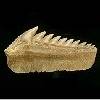 |
Hexanchus andersoni JORDAN, 1907
Extinct Sixgill shark.
Parasymphyseals are relatively common in the fauna, but complete anterolaterals are uncommon to scarce. |
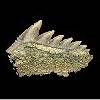 |
Notorynchus sp - Sevengill shark.
 Notorynchus was originally reported on this page, however it is now thought that this genus may not be present in the STH fauna. The presented example may have originated from another horizon or is a mesio-distally compressed Hexanchus lower. Notorynchus was originally reported on this page, however it is now thought that this genus may not be present in the STH fauna. The presented example may have originated from another horizon or is a mesio-distally compressed Hexanchus lower. |
| SQUALIFORMES |
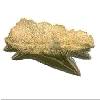 |
Echinorhinus blakei AGASSIZ, 1856
Bramble shark
A scarce species from Bakersfield, CA, The accompanying tooth is only 1.5 cm wide x 1cm high. Welton (1979) limited the occurrence of blakei to the STH bonebed and considered those from Pyramid Hill & Olcese Sands closer to E. cookei. |
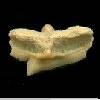 |
Squalus occidentalis (AGASSIZ, 1856) Dogshark
Originally listed as Squalus serriculus JORDAN & HANNIBAL 1923 this is now deemed a junior synonym of S. occidentalis1. Some prefer the more conservative Squalus sp. These teeth are quite abundant in the fauna. |
| SQUATINFORMES |
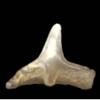 |
Squatina lericheii JORDAN & BEAL, 1913
Angel shark
These teeth are quite common and may actually represent the extant species S. californica AYRES, 1859.2 |
| HETERODONTIFORMES |
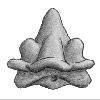 |
Heterodontus -- Bullhead shark The illustrated tooth is 3.0 mm in height. Based on studied material, these teeth are relatively common and are easily confused with male dasyatid teeth or are thought to be from skates, unless observed under magnification. |
| LAMNIFORMES |
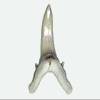 |
Carcharias taurus (RAFINESQUE, 1810) Extant Sand Tiger.
 There appears to be no evidence of Carcharias teeth in the STH fauna. Reports to the contrary likely result from specimens found in the Olcese Sand where this tooth-design is somewhat common.
There appears to be no evidence of Carcharias teeth in the STH fauna. Reports to the contrary likely result from specimens found in the Olcese Sand where this tooth-design is somewhat common. |
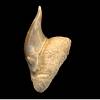 |
?Megachasma sp - Megamouth shark.
 Known from the Pyramid Hill Sand and Freeman Silt (both Early Miocene) there are no verifiable reports from STH or later sediments. These West coast teeth are significantly different than Lee Creek specimens and the extant species; possibly a different genus or species.
Known from the Pyramid Hill Sand and Freeman Silt (both Early Miocene) there are no verifiable reports from STH or later sediments. These West coast teeth are significantly different than Lee Creek specimens and the extant species; possibly a different genus or species. |
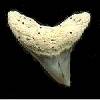 |
Alopias ?latidens (LERICHE 1909)
extinct Thresher shark
Thresher teeth are a relatively rare component of the fauna. |
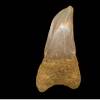 |
Cetorhinus sp — Basking shark
Originally identified as C. cf maximus (GUNNER 1765) it now seems more appropriate to go with a more conservative identification. These teeth are deemed a common component of the fauna. |
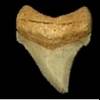 |
Carcharocles chubutensis (AMEGHINO, 1906)
extinct Mega-toothed shark
 Chubutensis teeth are not represented in the STH fauna. They are found (accompanying tooth) in older Miocene units in the area (Olcese Sand, Pyramid Hill Sand). Chubutensis teeth are not represented in the STH fauna. They are found (accompanying tooth) in older Miocene units in the area (Olcese Sand, Pyramid Hill Sand). |
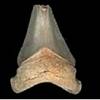 |
Carcharocles megalodon (AGASSIZ, 1837)
extinct Mega-toothed shark.
Jordan (1907) deemed these teeth different from their right coast counterparts erecting Carcharodon branneri. Leriche (1908) deemed them Carcharodon megalodon and Jordan & Beal (1913) followed suit. |
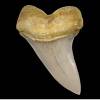 |
Cosmopolitodus (Isurus) planus (AGASSIZ, 1856)
extinct White shark
This tooth-design is abundant in the STH fauna. |
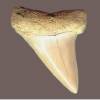 |
Cosmopolitodus (Isurus) hastalis (AGASSIZ, 1843)
extinct White shark
Teeth from this species are characterized by the broad flat labial root face. They are abundant in the STH fauna.
|
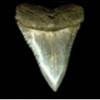 |
Cosmopolitodus sp (serrate, a.k.a. xiphodon) extinct White shark
 There is no evidence that serrate hastalis teeth are represented in the STH fauna. The accompanying specimen although purported from the fauna is more likely from another horizon or location.3 There is no evidence that serrate hastalis teeth are represented in the STH fauna. The accompanying specimen although purported from the fauna is more likely from another horizon or location.3 |
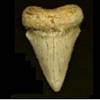 |
Carcharodon sp - Great White shark
 Carcharodon has been attributed to the fauna (including this website4); but a detailed review of well documented specimens and personal collecting history requires it to be removed. The accompanying image, originally ascribed to STH likely originated from a different location and horizon. Carcharodon has been attributed to the fauna (including this website4); but a detailed review of well documented specimens and personal collecting history requires it to be removed. The accompanying image, originally ascribed to STH likely originated from a different location and horizon. |
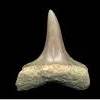 |
Isurus oxyrinchus RAFINESQUE, 1809
aka I. desori (SISMONDA, 1849)
Shortfin Mako shark
Relatively uncommon in the STH fauna.
|
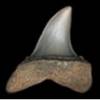 |
Isurus retroflexus (AGASSIZ, 1843)
aka I. paucus GUITART MANDAY, 1966
Longfin Mako shark
Mako teeth with labio-lingually compressed crowns are rare in the STH fauna. |
 |
Parotodus benedeni (LeHON, 1871)
extinct False Mako shark.
Teeth from this species are scarce in the fauna. |
| CARCHARHINIFORMES |
SPECIMEN
REQUIRED |
Cephaloscyllium -- Swellshark.
This Applegate determination was included in the fauna by Mitchell (1965) but not figured. An illustration or representative example of this tooth-design has not been seen. |
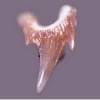 |
cf Scyliorhinus -- Catshark.
This Larry Martin specimen is from the Round Mountain Silt. This may be the design that served as the basis of the Cephaloscyllium identification above. |
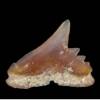 |
Galeorhinus sp - Tope shark.
Although scarcely found with complete roots, Galeorhinus teeth are common in the fauna. These teeth are not Jordan & Beal's (1913) G. hannibali which compares better with the Galeocerdo tooth-design. |
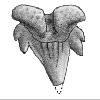 |
Triakis sp - Houndshark.
The BVMNH faunal list included Triakis beali JORDAN, 1919; there is question about the validity of that taxon. The accompanying STH specimen is similar to the extant Triakis scyllium MÜLLER & HENLE, 1839 |
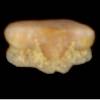 |
Mustelus sp - Smooth-hound shark.
Teeth thought to represent Mustelus are present in the STH fauna; due to their size (about 1mm high or wide) they slip past most screens or go unrecognized as fossils to the untrained eye. |
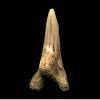 |
Hemipristis serra AGASSIZ, 1843
Snaggletooth shark.
Snaggletooth teeth from this site were originally assigned to H. heteropleurus Agassiz and H. chiconis Jordan (1907). There are no characteristics of these teeth that distinguish them from their east coast counterparts. |
GOOD
LUCK |
Carcharhinus antiquus (AGASSIZ, 1856)
This species was included in the BVMNH faunal list, but the illustration in Jordan (1907) was of poor quality and the tooth damaged. Jordan (1907) had originally identified this tooth as Agassiz's Prionodon antiquus but placed it in the genus Carcharias and in 1913, moved it to Carcharhinus but speculated it might be Carcharodon, possibly C. rectus. |
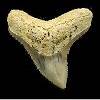 |
Carcharhinus cf "egertoni" (AGASSIZ, 1843)
extinct requiem shark.
BVMNH faunal list, illustration not seen. The underlying validity of this taxon remains in question due to the possibility it includes teeth from multiple species. |
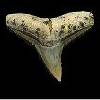 |
Carcharhinus cf limbatus (VALENCIENNES, 1839)
Blacktip shark |
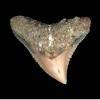 |
Carcharhinus obscurus (LeSUEUR, 1818)
Dusky shark
Very scarce in the STH fauna. |
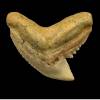 |
Galeocerdo aduncus (AGASSIZ, 1843) extinct Tiger shark
Jordan (1907) followed Agassiz and attributed these teeth to G. productus AGASSIZ, 1853. Leriche (1908) subsequently indicated that they were identical to G. aduncus; but, Jordan (1913) rejected this notion based on geographic considerations. |
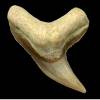 |
Physogaleus contortus (GIBBES, 1849)
extinct Tiger-like shark. The illustrated specimen measures 15.0 mm in height; common in the STH fauna. |
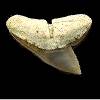 |
Sphyrna cf zygaena (LINNAEUS, 1758) — Hammerhead shark
These teeth have been reported as Sphyrna ?laevissima
|
SPECIMEN
REQUIRED |  Sphyrna cf media SPRINGER, 1940 — Hammerhead shark
Sphyrna cf media SPRINGER, 1940 — Hammerhead shark |
| RAJIFORMES |
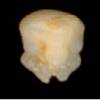 |
"Rhinobatos" sp - Guitarfish.
Relatively common in the fauna, these guitarfish-like teeth are rarely collected due to their sub-1mm size. Some aspects of the crown and root-design require the genus determination to be treated as speculative. |
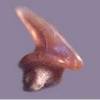 |
Raja sp - Skate. Unlike Lee Creek where skate teeth can be quite large and common, the accompanying Round Mountain Silt tooth is just over 1mm in height and might be deemed scarce in the fauna. |
| MYLIOBATIFORMES |
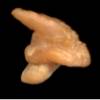 |
Dasyatis spp - Stingray. There appears to be three common stingrays in this fauna, the accompanying image is a high-cusped male of one of these tooth-designs.. |
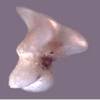 |
Gymnura sp - Butterfly Rays. Finding examples of this genus requires the retention and processing of 1mm-class material; the accompanying image is from the Round Mountain Silt. These teeth should be viewed as uncommon in the fauna. |
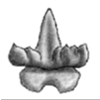 |
Mobula loupianensis CAPPETTA, 1970 -- extinct devil ray. The illustrated male tooth is 2 mm high. These teeth are only 1/10th as common as those from stingrays, but are still common within the fauna. |
EXAMPLE
REQUIRED |
Myliobatis merriami JORDAN & BEAL, 1913. In the STH myliobatid material, there appears to be Myliobatis and another design more reminiscent of Pteromylaeus; a third myliobatid may also be present. Referring to the 1913 illustration, this tooth-design may be Pteromylaeus. |
EXAMPLE
REQUIRED |
Myliobatis smithii (JORDAN & BEAL, 1913) These teeth were originally placed in Rhinoptera by Jordan and Beal; who reassigned them is currently unknown. I've seen hundreds of myliobatid teeth from this location, and none comparred well with the rhinopterid design. Illustrations from the original publication were unable to provide sufficient detail for a better identification. |
Footnotes
| 1 |
This species was reassigned to Squalus occidentalis by Welton in his 1979 PhD thesis, which has not been widely-read, leading to the continued usage of S. serriculus in several more recent papers. Welton's reassignment was discussed and confirmed by Long (1992) and Bigelow (1994). |
| 2 |
Living taxa are highly regionalized and virtually impossible to distinguish on the basis of isolated teeth. Others have speculated that Squatina lerichei may be a junior synonym of S. occidentalis EASTMAN 1904, which itself, may be a junior synonym of S. subserrata MÜNSTER 1846. Eastman does not give a detailed description of S. occidentalis, nor does Münster give one of S. subserrata. |
| 3 |
This specimen does not appear to be from the bonebed as the color does not look right and the morphology has never been formally documented from the bonebed or the formation. It does, however, bear a resemblance to teeth from a Late Miocene-Early Pliocene deposit at Oceanside, San Diego County, CA. The Oceanside teeth grade from a gray to gunmetal blue color. |
| 4 |
The original comments on ELASMO.COM were: It is commonly assumed that the serrate lamnid teeth from Sharktooth Hill came from Carcharodon carcharias (LINNAEUS, 1758). Jordan saw more than one species in the fauna. He assigned teeth to C. rectus AGASSIZ ["perhaps nearer than any others here named to the living man-eating shark, C. carcharias"] but later (1913) noted that they might be C. megalodon with a lateral denticles (sounds like juvenile Carcharocles megalodon.). Another [now thought to be from a Pliocene horizon], he named C. arnoldi [noting, "serrae rather smaller and more numerous" than C. riversi] then resisted Leriche's attempt to shoe-horn this tooth into C. carcharias. (sounds like the serrate Cosmopolitodus hastalis). A third he named C. riversi ["denticles fewer and coarser than in any other species".] (sounds like Carcharodon carcharias). |
REFERENCES
Agassiz, L. 1856. Notice of the fossil fishes found in California by W.P. Blake. in Blake, W.P. Description of the Fossils and shells collected in California. American Journal of Science. Series 2. Vol. 21: 272-275.
Bigelow, P.K. 1994. Occurrence of a Squaloid Shark (Chondrichthyes: Squaliformes) with the Pinniped Allodesmus from the Upper Miocene of Washington. Journal of Paleontology 68 (3): 680-684.
Eastman, C., 1904. Pisces. In: Maryland Geologocal Survey - Miocene. John Hopkins Univ Press, Baltimore 543 pp, 135 pls.
Jordan, David S., 1907. The Fossil Fishes of California with supplementary notes on other species of extinct fishes, in: Bulletin of the Department of Geology, Vol 5, No 7. University of California. pp 95-144.
Jordan, David S. and Beal, Carl H., 1913. Supplementary notes on fossil sharks, in: Bulletin of the Department of Geology, Vol 7, No 11. University of California. pp 243-256.
Leriche, M. 1908. Observations sur les Squales néogènes de la Californie. Annales de la Société Géologique du Nord, 37, pp. 302-306.
Long, D., 1992, Sharks from the La Meseta Formation (Eocene), Seymour Island, Antarctic Peninsula. Journal of Vertebrate Paleontology 12 (1): 11-32.
Mitchell, E., 1965. History of research at Sharktooth Hill - Kern County California.. Kern Co. Hist. Society, CA.; 45pp.
Muenster, G. von. 1846. Ueber die in der Tertiär-Formation des Weiner Beckens vorkommenden Fisch-Uebereste, mit Beischreibung einiger neuen merkwürdigen Arten. In Beitrage zur Petrefacten - Kunde.
Sanchez, F. and Prothero, D.. 2003. Magnetic Stratigraphy of the Miocene Round Mountain Silt and Olcese Sand, Bakersfield, California. Geological Society of America Abstracts with Programs, Vol. 35, No. 6, September 2003, p. 160.
Welton, B., 1979 Late Cretaceous and Cenozoic Squalomorphii of the Northwest Pacific region. - Unpubl. Ph. D. thesis, Univ. Calif.Berkley, 553 pp.
Wood II, H.. Chaney. R., Clark, J., Colbert, E,, Jepsen, G., Reeside, J. and Stock, C.. 1941. Nomenclature and correlation of the North American continental Tertiary. Bull. Geol. Soc. Am. 52: 1-48.
WEB REFERENCES
Related sites to visit:
Tanaka Takeshi's Sharktooth Hill page.
Kern County Mineral Society
websites
Also visit Dr. Ron Blakey's
website on the stratigraphy of the Southwestern US. His page on
Miocene Paleogeography, Southwestern US
will give you a taste of the contents.
If you can provide feedback or help us with this effort, contact Jim Bourdon using the below email link.
|